The Wolf Park in Antequera
Friday, August 30, 2024
Nestled in the heart of Andalusia, near the historic city of Antequera, lies a unique wildlife reserve that is unlike any other in Europe – the Lobo Park. This non-profit sanctuary stands dedicated not just to the preservation and study of the majestic wolf but to the education of the public on the importance and nature of this often misunderstood creature.

A Guided Journey Through The Wild
At Lobo Park, visitors have the rare opportunity to observe wolves in a semi-natural environment through a variety of guided tours. The park offers regular guided wolf tours, each carefully designed to provide insightful knowledge about these fascinating animals. Imagine embarking on a tour with an expert guide leading the way, sharing facts and stories about the wolf packs that call Lobo Park their home.
For those seeking a more exclusive experience, VIP wolf tours are also available. These tours afford you a personal journey through the park, guided by experienced personnel, ensuring an intimate and in-depth encounter with the wolves.
Howling Under the Full Moon
One of the park's most enchanting experiences is the Howl Nights. Held under the glow of a full moon, these events offer a surreal experience of hearing the wolves' haunting howls fill the air. Seats for these magical nights are highly coveted, though limited places remain for the 19th of September 2024.
A Commitment to Education and Preservation
Lobo Park's mission extends far beyond mere observation of these noble creatures. As a non-profit association, it is deeply committed to the research and study of wolves, aiming to educate not just about wolves but also about the broader topic of dog education. Various programs like wolf seminars, school programmes, and more emphasize this educational commitment.

Adopt-A-Wolf: A Unique Connection
For those who wish to support Lobo Park even further, the Adopt-a-wolf program offers a unique opportunity to form a symbolic bond with these incredible animals. Whether it's adopting Gregori, the European wolf born on April 22, 2018, or Anouk, the Hudson Bay wolf born on April 10, 2019, your support directly contributes to the welfare and continued conservation efforts for these wolves.
Visiting Lobo Park
Located strategically at Ctra Antequera - Álora A343 km 16, 29200 Antequera, Málaga, Spain, Lobo Park is easily accessible. Paired with reasonable entry fees of €13.50 for adults and €8.50 for children aged 3-12, it's an educational adventure that's both enriching and accessible.
With a passion for education and wildlife conservation at its core, Lobo Park invites everyone to learn, support, and become part of a meaningful journey in understanding and conserving the mystique of wolves. Whether through a visit, participation in events or even adopting a wolf, each gesture helps in fostering greater respect and knowledge about these remarkable creatures.
 2
Like
Published at 10:03 PM Comments (0)
2
Like
Published at 10:03 PM Comments (0)
Bread, bread and more bread...
Thursday, August 15, 2024

Menus with or without wine, white with fish and red with meat, pairings or harmonies, dry for an aperitif and sweet for dessert... the culinary world is full of indecision. Questions can also arise with bread, although until now portions have worried us most: should we have one or half? Or maybe a third? However, we have learned that this "accompaniment" is an important part of any meal, meaning doubt can pervade this element as well. More and more shops are opening up dedicated to the world of grain-based products, although many seem more like fashion boutiques than bakeries.
The Spanish eat a lot of bread so shouldn't we also include it in our list of flavours? Keep in mind that this product is a key part of the Mediterranean diet and it is recommended to consume about five 40 gram-portions a day. It is also full of vitamin B, minerals and fibre, with a higher quantity found in wholegrain bread.

As for palates, each person knows their own well. But cooking is also guided by common sense and bread is no different. For example, if you eat something with sauce, doughy bread would always be recommended for mopping it up. But things change if you have a sandwich to be eaten standing up as you must consider a bread with a harder crust which can support the weight of the filling.
It is also normal to recommend that a flavourful bread should be eaten with things that won't mask the taste, like softer cheeses or mild cured meats. And on the contrary, if you have a very flavourful 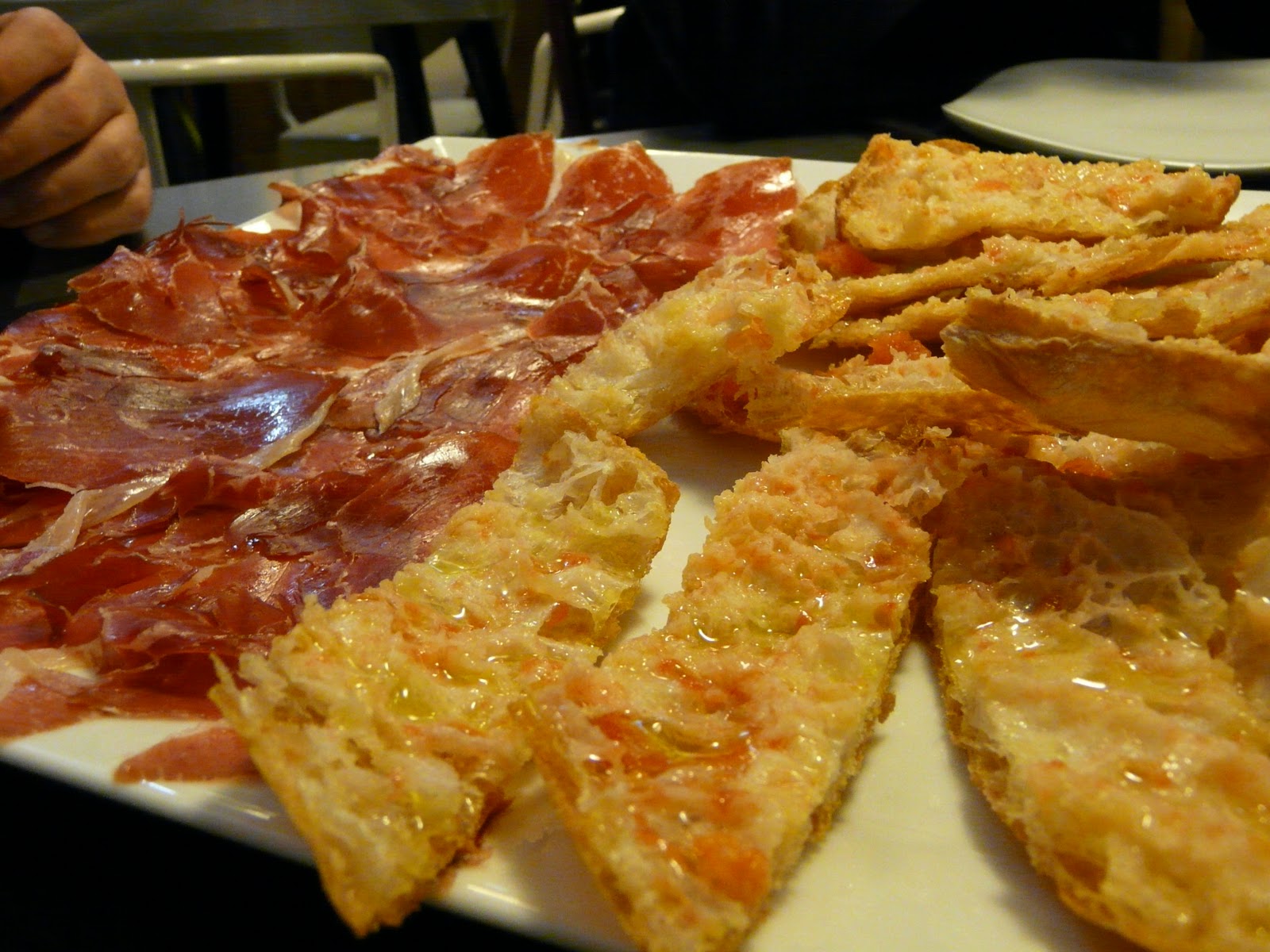 meal, it is best to opt for a white, seedless bread that only contributes texture and a mild flavour. meal, it is best to opt for a white, seedless bread that only contributes texture and a mild flavour.
Among the obvious harmonies are crunchy white bread such as 'Pan de Cristal' or crackers with cured meats, serving as a contrast to their saltiness; Smoked fish goes well with rye, as its dough has a more bitter taste; and corn bread goes well with sweet foods such as jams, butters and quince jelly. White bread, the classic loaf, is perfect for lamb or roast meats and wholegrain goes well with strong soups and stews for its intense flavour. Country bread, with its compact dough, is ideal with rice as well as for sandwiches with melted cheese.

Lastly, we have what is known in Spain as black bread, associated with central European countries. Bursting with flavour, it is suitable for fatty foods like salmon, smoked fish and salads with bitter vegetables like spinach, arugula and endive. Fortunately we have such a wide choice of breads available to us so try some new textures and flavours, it really is a world of its own.
 4
Like
Published at 2:27 PM Comments (0)
4
Like
Published at 2:27 PM Comments (0)
Jellyfish to look out for this summer in Spain
Wednesday, August 7, 2024
Jellyfish are invertebrates which present special cells used to capture prey and defend themselves. These cells have a poisonous capsule inside. When a prey or predator makes contact with the jellyfish, the capsule opens and the cells stick to them, injecting poison. Jellyfish are usually transparent as they are 95% water, allowing them to camouflage easily.
They usually live 20 to 40 miles from the coast where the water is saltier and warmer. If it has been a dry winter and rainfall has been low, the water at the beach may be of similar salt levels, thus providing a favourable environment for jellyfish. However, the main cause for an increase of jellyfish in an area is the marine currents and overfishing, especially when tortoises are captured, as these are the main jellyfish predators in the Mediterranean.
Types of Jellyfish in the Mediterranean
Fried Egg Jellyfish / Medusa Huevo Frito (Cotylorhiza Tuberculata)
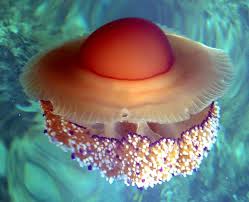 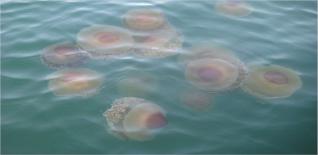
Sting level: not very painful.
They are yellow and look like fried eggs, usually 17cm wide. They are common in the Mediterranean during summer and autumn. These jellyfish can sting and cause temporary itching, but do not require medical assistance.
Common Jellyfish / Medusa Común (Aurelia Aurita)
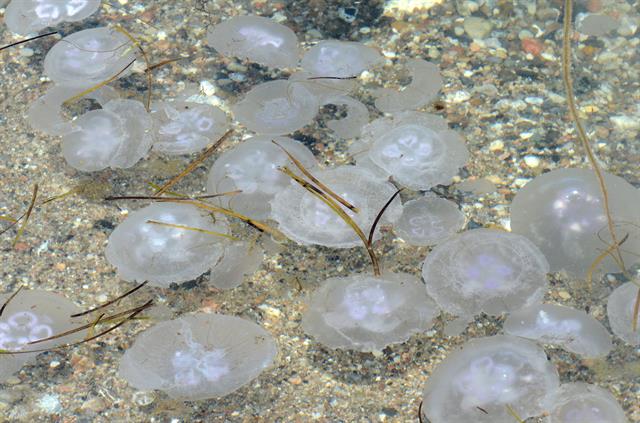
Sting level: not very painful.
Round, like a cup, usually white with pink or blue tones and have long tentacles, they are normally about 25cm wide. They are easy to find near the coast. Contact causes irritation and itching. Applying ice may reduce symptoms, but medical assistance is not required.
Compass Jellyfish / Medusa de Compases (Chrysaora Hysoscella)
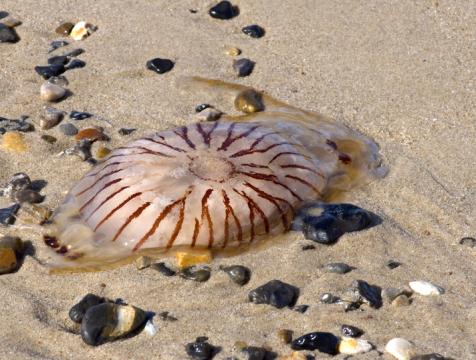
String level: painful.
Looks like an umbrella, usually white and yellow, they are around 20cm wide. They are not very common near the coast but live in the Mediterranean Sea. Causes an itching and burning sensation and can scar the skin for up to 3 weeks.
Shiff Arms Jellyfish / Aguamala (Rhizostoma Pulmo)
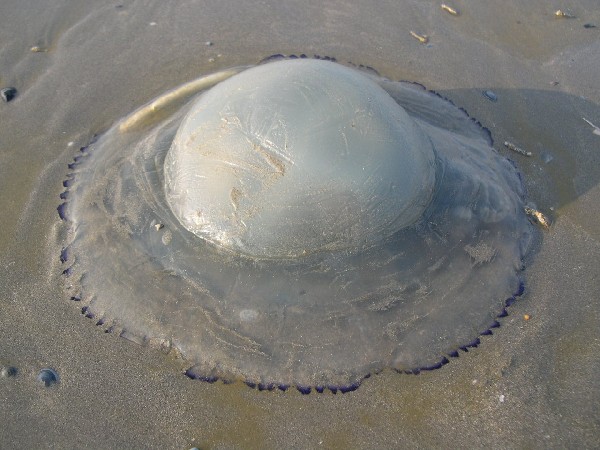
Sting level: painful
They are one of the more beautiful jellyfish in the Mediterranean and are about 50cm wide. They are bluish with a purple ribbon and have 8 tentacles, which if touched causes pain, but no other effects.
Pink jellyfish (Pelagia Noctiluca)
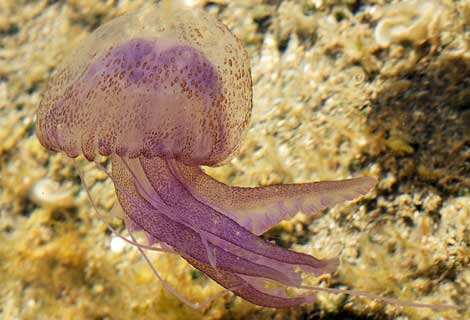
Sting level: painful and dangerous.
It is a 10cm fluorescent jellyfish, transparent with pink or purple tones. It has 16 long tentacles that can cause pain, burning, nausea and muscle cramps. They are not very common, but if seen do not touch them!
Portuguese Man o’War / Fragata Portuguesa (Physalia Physalis)
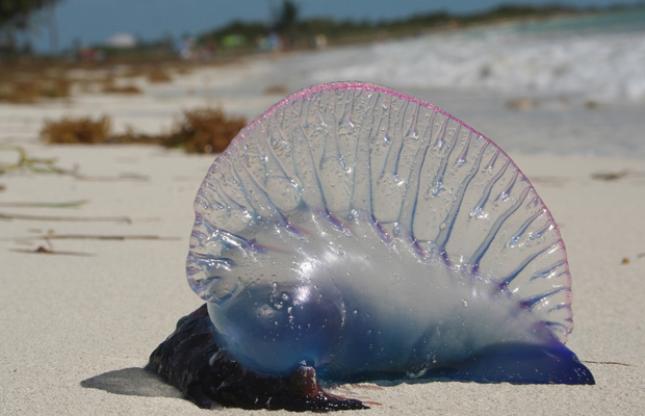
Sting level: very painful and extremely dangerous.
Not technically a jellyfish, but treated as one. The most dangerous sea creature found in the Mediterranean. It floats on the sea, has a purple colour and is about 10cm high. Its tentacles can be 2 meters long and they are fast swimmers. They can cause extreme pain, fever burns to the skin and neurological shock. Due to their dangerous nature, the Spanish Coastguard keeps watching for them and reports are issued on the local TV, radio and newspapers if they approach the coast.
Purple Sail or Velella / Medusa Velero (Velella Velella)
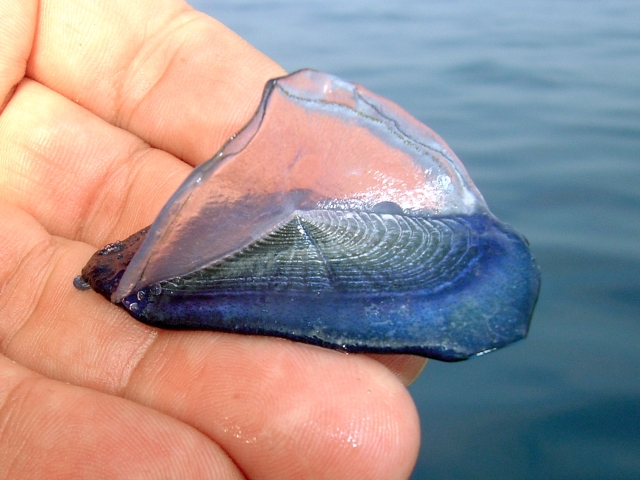
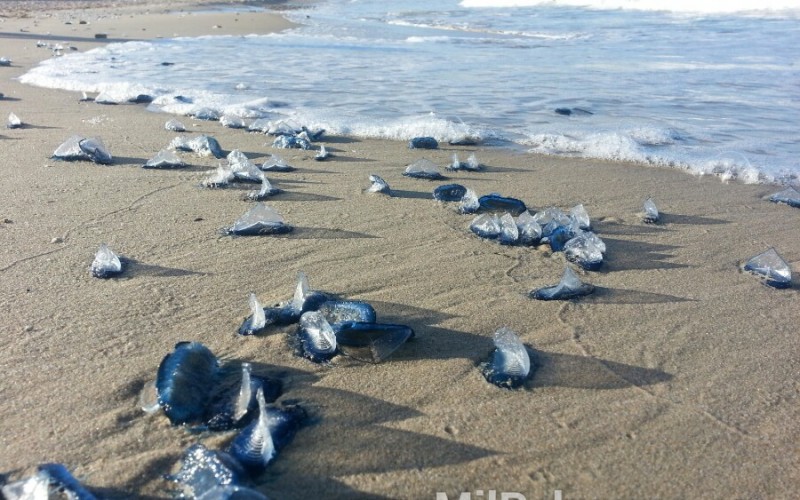
Sting level: not harmful to humans.
As with the previous one, not technically a jellyfish, but treated as one. With an approximate diameter of 6cm, they have a transparent stiff sail and their body is deep blue with circles. It is a carnivorous species, catching its prey with its tentacles and is very difficult to spot. They move by catching the wind on their sails. Their venom is not harmful to humans.
What to do if there are jellyfish at the beach?
1. Do not get in the water, keep an eye on the shore too.
2. If one jellyfish is spotted, there will probably be more around.
3. Do not touch them even when they appear dead. It takes 24 hours for the sun to deactivate its poison.
4. If stung:
a. Do not scratch the skin with sand or a towel.
b. Do not pour fresh water over the affected area.
c. Apply ice for 15 minutes. Ice must be inside a plastic bag to avoid freshwater melting onto the affected area. If the area is still painful, seek medical attention.
 1
Like
Published at 11:36 AM Comments (0)
1
Like
Published at 11:36 AM Comments (0)
7 Summer Plagues
Saturday, August 3, 2024
Some pests are typically summer visitors, such as mosquitoes or flies, but changes in environmental or climatic conditions, as well as the expansion of some species of invasive insects in the context of globalization, are altering and complicating these sanitary controls. The tiger mosquito, rats and bed bugs are some of the most fearsome pests; but there are more... Environmental health professionals are concerned and ask that we don't lose sight of this as things can get out of control very quickly... These are the 7 summer plagues...
1) Rodents
The presence of rodents has risen between 20% and 25%, according to the Catalan Association of Environmental Health Companies of Catalonia (Adepap). "The rats are now more daring and brazen," says Quim Sendra, its president. It is an effect of having gained ground during confinement. The result is the sensation that many citizens now see them twice as much as before.
The changing habits of rats and the increase in restrictions on the use of some biocidal products, added to the great adaptability of rodents and the resistance that sometimes appears makes it increasingly complex to maintain populations below the established tolerance thresholds.
Companies in the sector ask the Ministry of Health for exceptions to relax the restrictions imposed on the use of insecticides.
Rats have space and more food resources in cities; and if its only predator, man, loosens the controls and treatments, the pests will increase, warns Sendra, who is concerned about the risk that the administration's decision to lower their guard and reduce the budgets and the technical personnel dedicated to this task. Rats are very harmful to environmental health since they are carriers of insects or arthropods that can transmit zoonotic diseases.
2) Tiger mosquito

Precipitation in the spring, as well as high temperatures, have created a breeding ground for mosquitoes, creating ideal habitats for the larval stage.
These conditions favour the increase in adult mosquito populations, which are the ones that cause the main discomfort to people with their bites, as well as with the possible transmission of viruses and diseases.
Climate change means that many species are here all year round according to Quim Sendra, president of Adepap, referring to the tiger mosquito (Aedes albopictus), which has more diurnal activity than common mosquitoes and reproduces with very little water, stagnant in small spaces most of the year.
Professionals recommend preventing them from creating places conducive to laying eggs and the development of the aquatic larval phase (sewers, drains, sinks, pot trays, drums.)
3) Invasive species
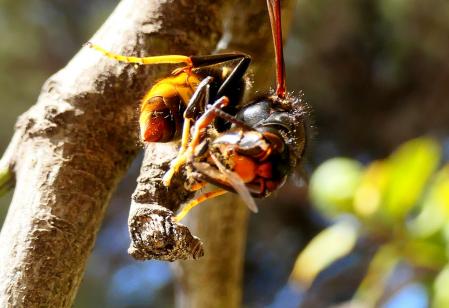
Experts are closely following the recent arrival and expansion in Spain of Aedes japonicus, from the East, and Aedes aegypti, originally from Africa. Both species, along with the tiger mosquito, much more present in our country, are vectors of viruses such as dengue, chikungunya and zika, and there have been cases in humans in Spain.
By the end of summer, it is also expected that there will be an increase in the cases of Asian wasp hives ( Vespa velutina ssp. Nigrithorax ), a predator that attacks the honey bee, with a great capacity for adaptation, and which grows year after year in Spain. However, beekeepers from Girona have recently stated that the installation of more traps to capture Asian wasps in May has reduced the presence of this invader. The stings of this wasp cause intense pain, followed by itching similar to that of a burn.
4) Bed Bugs
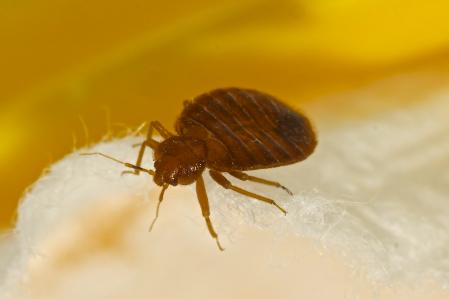
The increase of bed bugs comes with tourism. "They travel with the tourists. They don't walk, they don't fly, but they travel through our luggage”, says president of Adepap. Bed bugs ( Cimex lectularius ) arrive at homes in most cases transported in their own clothes or travel bags. The pests of this insect are quite difficult to eliminate, since "during the day they hide in corners, cracks in the wood or folds of clothing, especially in mattresses and sofas, and come out at night to suck blood," says Sendra .
5) Cockroaches
Companies also predict the appearance of cockroach infestations (sewer, brown, oriental, black, and brown, common in homes and restaurants). Adepap emphasizes that to combat pests it is always better to have professionals, since "some misused domestic insecticides can become a problem for people's health, they are not always effective and end up having a high economic cost".
6) Black fly
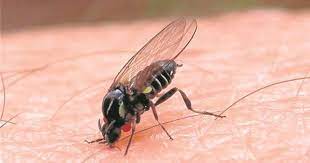 Black fly (Simuliidae) plagues are located mainly in spaces such as rivers and streams, and often affect municipalities with abundant water flows. Before it was limited to areas such as the Ebro River; but in recent years it has spread to many riverbeds. The black fly bite is very annoying and painful; it can cause severe itching and even edema and requires treatment with antihistamines and antibiotics, in case of infection. Black fly (Simuliidae) plagues are located mainly in spaces such as rivers and streams, and often affect municipalities with abundant water flows. Before it was limited to areas such as the Ebro River; but in recent years it has spread to many riverbeds. The black fly bite is very annoying and painful; it can cause severe itching and even edema and requires treatment with antihistamines and antibiotics, in case of infection.
7) Fruit fly

Professionals see it as necessary to exercise extreme vigilance over Drosophila melanogaster, controlling both the food industry and domestic kitchens, since they can carry pathogenic microorganisms, such as Salmonella and Escherichia coli bacteria, attached to the villi of the body and legs, and contaminate in this way food and surfaces on which they perch.
Stay alert and vigilant!
 3
Like
Published at 10:12 AM Comments (0)
3
Like
Published at 10:12 AM Comments (0)
Spam post or Abuse? Please let us know
|
|